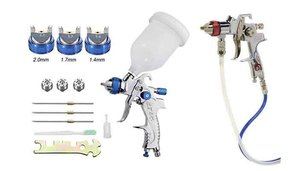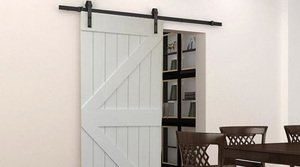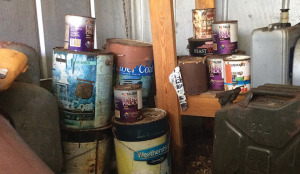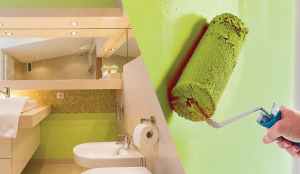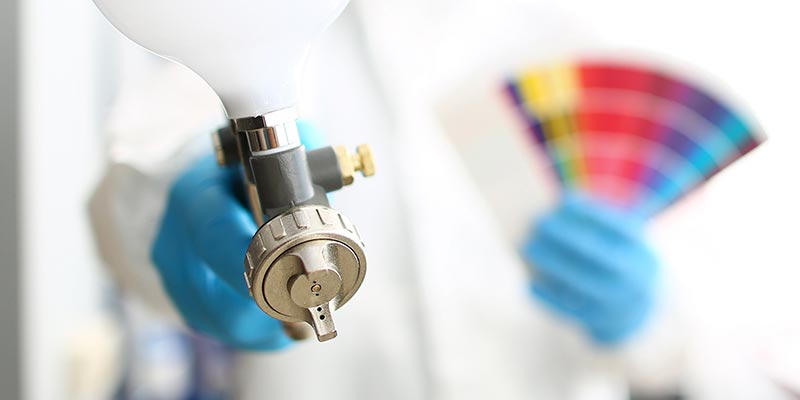Planning to paint your walls but unsure how to handle the cracks and holes? In this guide, we explain how to fix wall crack lines and other minor surface damage in preparation for house painting.
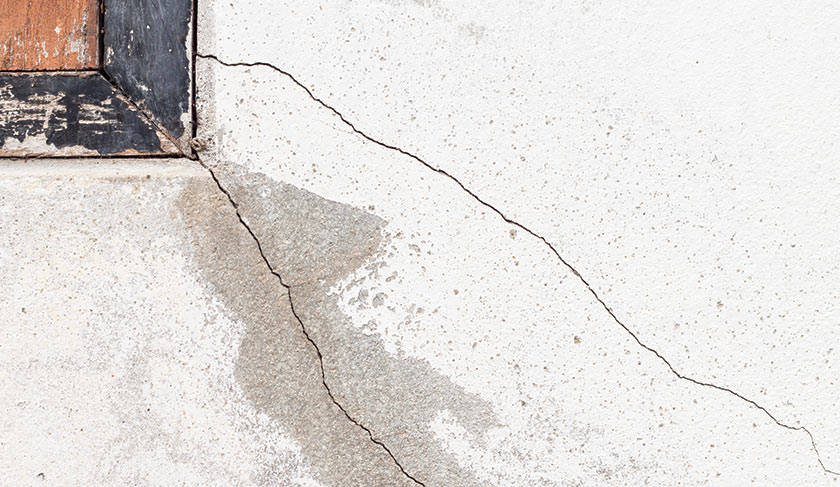
Chances are if you’re planning to paint your house, then it is probably a little worse for wear. Your house probably shows the signs of living over the years, in the form of scruffs, scratches, dents and damage to your walls.
Fortunately, in most cases these marks are just surface level wall cracks and holes that can be fixed easily, without a tradesperson. However, if you don’t repair the damage before painting, they will show through your new paint work like a sore thumb.
To get the best paint finish possible, make sure to take some time to inspect your walls for any minor cracks, holes or other imperfections, and repair them.
In this guide, we explain step-by-step how to fix wall crack lines and holes in plasterboard (drywall) and plywood to get your walls ready to go for painting.
How to Fix Wall Crack & Holes in Plasterboard (Drywall)
Nothing is worse for a homeowner or a renter than having to deal with holes or cracks in the plasterboard. The average person can quickly and easily fix holes or cracks, depending on the severity of the damage, if they know the proper steps to follow.
For minor imperfections, you can probably get away with using some filler, without learning any special techniques for how to fix wall crack problems. To do so, simply pick up some plasterboard-suitable filler from your local hardware store (they often come in small bottles with a cute little built in scraper, also called spackle), and follow the instructions on the bottle. However, if your drywall wall crack or hole is a bit larger, follow the steps below.
How to Repair a Surface Crack in Plasterboard Wall
Because of the way in which plasterboard is manufactured, it will very rarely have a crack or a split at any point other than where the sheets meet one another. This seam that is formed where the two sheets come together, can be easily fixed.
Regardless of whether the crack is vertical or horizontal:
- Widen the crack. Start by widening the crack using a utility knife or scraper, in order to create a v-shaped valley. This might seem counter-intuitive at first (why make your crack bigger?) but this valley will give you a good surface in which to fill using drywall compound.
- Fill the crack with drywall compound. Holding the putty knife at a roughly 70 angle, swipe across the crack filling it in with the compound. It’s important that the putty knife contacts both sides of the plasterboard, in order to ensure an even seam.
- Allow to dry, then sand and paint. Once the compound has dried completely, you can then sand and paint it.
How to Repair a Deep Crack in Plasterboard Walls
Deep cracks refer to any type of crack that extends through the paper that encases the plasterboard. It will take a little more effort to repair a deep crack than it does for a surface crack.
The general steps are outlined below, but we recommend that you talk to a tradesperson or local hardware store while buying the compound and fiberglass tape, so you understand the steps properly, before tackling it on your own.
You will also want to investigate the cause for a deep crack, as it could indicate serious underlying issues, especially if the wall crack cause was not clear.
For additional instructions on repairing drywall cracks, check out this Spruce article.
Steps to Fix Wall Crack in Plasterboard – Deep Cracks:
- First, if the crack is on the seam… If the crack occurs at a seam, you will want to pull away any loose tape from the wall and cut the tape roughly 6 inches away from the damage. You can then scrape away any loose compound with a knife before expanding the crack
- Expand the crack. Expand the crack all the way through to the stud cavity. It’s important to make sure that you do not remove any compound that extends beyond the crack.
- Fill the crack with compound. Once removed, you can fill the crack with new drywall compound, as well as cover any spots on the wall where the tape was removed.
- Place fiberglass tape over the crack, while wet. While the drywall compound is still wet to the touch, you will want to cut and place a strip of fiberglass tape to cover the entire crack.
- Flatten the surface. Use your putty knife to flatten everything out, and make it level.
- Allow to dry, then sand and paint. As with surface cracks, once the putty has dried completely, you can sand and paint it.
How to Repair Nail Pop in Plasterboard Walls
One of the more common issues associated with plasterboard is nail pops. While most newer homes use screws to attach the plasterboard, some homes were manufactured using nails instead. When the wood in the wall begins to warp, it causes the plasterboard to flex, thereby causing the nail head to pop out. The plasterboard itself is not in any real danger of falling, but the bumps can be unsightly.
The easiest way to fix nail pops is to:
- Hammer the nail back in. Drive nails back into the wall by placing a screwdriver on the head of the nail and tapping it with a hammer.
- Insert an extra screw into the wall. Once the hammering is done, you will want to also drive a drywall screw into the stud within an inch or 2 of the nail. This will hold everything tightly.
Once done, you will need to cover the area with new drywall compound, and a small piece of fiberglass tape.
Plasterboard Corner Bead Repair
One of the harder things to fix on a plasterboard wall is the corners. When the wall is first constructed, a corner bead is placed over the corner in order to protect it. Drywall compound is then used to fill in the space between the wall itself, and the height of the bead. Generally, corner bead damage is limited to smaller areas where the compound has been cracked or chipped off.
So long as the bead is not dented, you can simply remove any loose compound using a putty knife, and refill the space with new compound. However, if the bead is dented, then you will need to carefully cut out and replace the damaged section. This will generally require using a hacksaw and tin snips, as the bead is composed of sheet metal. Once the new bead has been attached using screws or nails, simply level out the area with drywall compound, sand smooth, and paint.
Plasterboard Small Hole Repair
A small hole refers to any type of hole that is smaller than 6 inches in diameter. Most home improvement stores offer repair kits that include a reinforced panel with sticky tape that provides an area of support for the drywall compound. Simply adhere to the supplied patch and cover it with compound.
How to Repair Small Holes in Drywall without a kit
Although kits are available, you may also create your own patch as long as the hole does not extend from one stud to the other. You will still need to reinforce the hole and provide some sort of structure to which to attach the compound to.
- Cut a scrap of drywall that is just slightly larger than the hole itself.
- Trace around the scrap of drywall, and cut the underlying plasterboard to match.
- Find a couple of pieces of scrap wood to create a support structure inside the wall, and screw them in place.
- Next, you can screw your piece of scrap drywall in place to fill in the hole.
- With the help of drywall compound, you can fill in the crack between the original wall and the repair piece.
- Cover the wet compound with fiberglass tape and smooth out with your putty knife.
- Allow to dry fully, then sand and paint.
Large Section Repairs in Plasterboard Walls
Larger holes are those which extend across one or more wall studs. This type of repair requires more reinforcement than any other type of hole. It’s important to make sure that there is nothing inside of the wall before you begin cutting, such as pipes or electrical. Once you have determined the location of the studs, carefully cut out the damaged section of drywall all the way up to the studs, but do not cut through them. Discard any old damaged drywall, and remove any old screws or nails.
This is not a beginner DIY task, so if you are feeling uncertain, it is best to call over a handy friend or hire a tradesperson to fix the damage for you.
Overview and Tips:
- You will need to add some cleats, which are effectively scraps of lumber that can be used to reinforce the seams where the replacement patch will meet the original drywall.
- Be sure to use plasterboard that is the same thickness as the original, and cut it to fit.
- Once it has been screwed in place, cover the seam with putty and fiberglass tape.
- After the compound has dried then simply sanded smooth and paint it as normal.
How to Fix Wall Crack & Holes in Plywood
Unlike fixing holes and cracks in plasterboard, repairing timber and plywood walls are a little more difficult, however, it is not impossible. I have done it myself while preparing to paint the plywood walls in my home interior, and while it takes time, learning how to fix wall crack marks and gouges in plywood is manageable even for beginner DIY’ers.
For small holes and cracks, it is very easy to fill the holes with some wood putty or filler designed for timber. To do this, fill the hole or crack with the wet putty using a scraper, and allow it to dry fully. Then, simply sand over the area, and it is ready to paint. Putty is also great for levelling out unsightly knots in plywood, to create a smooth surface prior to painting.
For holes and cracks that are too large for timber putty, then you will need to undertake some more involved repairs. Steps for this are below.
Steps to Fix Wall Crack & Holes in Plywood (Large Sections)
#1 Prepare the Area
Start by preparing the area that is going to be repaired. This will give you the opportunity to determine the thickness of the original plywood. It is very important that the original and repair pieces are the same thickness, or otherwise, the repair will look unsightly.
#2 Mark the Area and Cut a New Hole
Next, you want to cut a piece of plywood that’s going to be slightly larger than the hole itself. Using the repair piece as a guide, mark the original plywood by tracing along the outside. Cut along the markings, to ensure a snug fit. It does not have to be perfect, but it should be as close as possible.
#3 Screw a Furring Strip on the Inside of the Wall
Now you will need to screw a furring strip or two, inside of the original wall along the cuts in order to give you something to attach the repair piece to. You can use just about any type of lumber, as long as it is strong enough to screw into securely. Sometimes, it is easier to put in a few afferent furring strips, simply because of how challenging it is to hold the piece of wood and screw it in at the same time.
#4 Secure the Plywood Patch to the Furring Strip
Finally, you want to fit the repair piece into the hole and screw it to the furring strips you previously attached. When finished it should fit snugly, but does not have to be perfect as you will be filling in the seams with wood filler. Just remember, that the larger the gap, the more wood filler you will need to complete the process, and the greater chance that the repair will be visible when finished.
#5 Fill the Seams Using Wood Filler
Using a putty knife, press the wood filler into the seams. Make sure to apply it as liberally as possible. It’s okay if there is extra protruding above the seam. This is important as wood filler does tend to shrink a bit once it dries. It does not have to be perfect, but there does need to be enough that you can stand it smooth when finished.
#6 Sand the Area
Once the wood filler has dried completely, you can begin the sanding process. Be careful when sanding that you do not sand into the seam itself. You will want to use a sanding block in order to ensure that the seam is level with the wall once finished.
For additional instruction on repairing damaged plasterboard, see this article from SF Gate.
Final Thoughts on Fixing Walls before House Painting
By now you should have a clear idea of the steps you need for how to fix wall crack, holes and imperfection in your plasterboard (drywall) or plywood walls, before you start painting. In general, minor cracks and imperfections are very easy to fix, and most of them can be repaired with some filler or putty applied with a scraper. For larger damages, we’ve made an effort to share the repair steps as well as possible.
However, these repairs will add extra time to your project, sorry to say. So, I know what you are wondering:
Is it really necessary to fix those surface wall cracks and nail holes?
Won’t the paint just fill them in and hide them?
Oh, if only! No, on the contrary, a new coat of painting actually highlights surface imperfections even more. I’ve done this myself, thinking the paint would just cover it up, but it doesn’t, and ends up looking worse. I don’t really understand why, but I can tell you that paint does not hide them. Painting straight over them makes the surface look unattractively uneven and bumpy.
So, don’t skip your wall repairs! But, if you’re looking to save time, have you considered using a paint sprayer instead of a roller and brush? If not, then you definitely want to check out these awesome time-saving machines, you can learn more in our beginners guide to paint sprayers here.
And, when you’re ready to paint, don’t forget to check out our complete guide to painting house interiors, including preparation steps.
Happy DIY’ing!
Author

Hey, I’m Sara, co-owner of NestKoo! I’m a graphic designer and professionally trained fine artist, with a Bachelor of Arts (Fine Art) majoring in Painting. I love being close to nature, sustainable living and bringing new life to old things. My specialty in NestKoo is DIY house painting, upholstery and furniture upcycling, where I bring my skills in fine art painting and contemporary design together into a practical home DIY context.
View all posts



